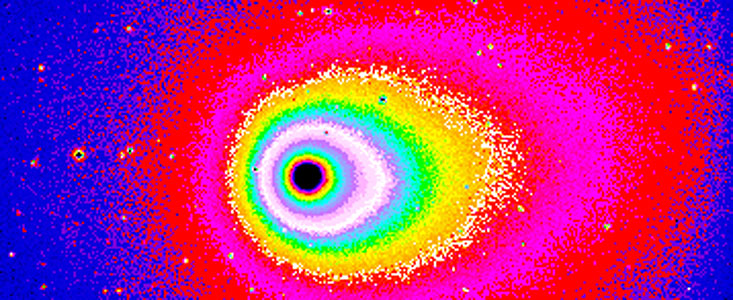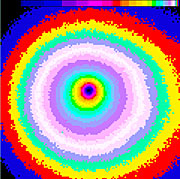Nota de Imprensa
The Innermost Coma of Comet Hyakutake
2 de Março de 1996
These false-colour images are reproductions from a short-exposure CCD frame, obtained with the Danish 1.54-metre telescope and the DFOSC instrument with a 2052 x 2052 pix Loral/Lesser CCD. They show the innermost coma of Comet Hyakutake and the pronounced asymmetry of the dust distribution around the nucleus.
The exposure lasted 60 seconds and was made through a red filtre (R) at 06:37 UT on February 29, 1996. The sky condition was not optimal and the seeing was about 1.5 arcseconds. The observers were Klaus Simon (Institute for Astronomy and Astrophysics, University of Munich, Germany) and Chris Lidman (ESO-Chile); the image processing was done by Stefano Benetti (ESO-Chile). The pixel size is 0.39 arcsec and the original frame covers an area of 13.3 x 13.3 arcmin. On both photos, North is up and East is left.
At the time of this observation, Comet Hyakutake was 0.843 AU (126 million kilometres) from the Earth, and 1 arcsec on the photos corresponds to a little more than 600 kilometres projected. The distance to the Sun was 229 million kilometres.
The first photo (eso9615a) displays an area of approx. 9.2 x 6.7 arcmin. The typical elongation in the anti-solar direction (at p.a. = 290 deg, i.e. West-North-West) is very pronounced. The asymmetry in the upper-right quadrant (North-West) is also obvious. When moving outwards from the nucleus (located within the black area), the isophotes (curves of equal brightness; particularly well shown by the contrasting colours on these photos) turn anti-clockwise over an angle of about 20 degrees. This effect is caused by the repulsive action on the dust grains by the solar photons.
On this short exposure and in this wavelength region (6000 - 7000 A), only reflection of sunlight from dust grains is seen. The largest extension of the dust coma (East-West) is just over 7 arcmin, or 260,000 kilometres projected.
The second photo (eso9615b) is a close-up of the innermost coma. The field measures about 45 x 45 arcsec (27,500 x 27,500 kilometres projected) and although the isophotes appear more round than on the other photo, their asymmetry is also evident on this scale. This is particularly obvious at the edges of the field.
The nucleus is located where the intensity is highest; this position is offset towards North-West from the geometric centre of the innermost isophotes here resolved, i.e. those within 3-4 arcseconds (10 pixels) from the peak of light. This indicates that the dust is mostly coming off the nucleus in the South-East direction, i.e. from the surface area that is illuminated by sunlight (as expected). A detailed analysis of this image - still to be performed - will allow to determine the outflow charateristics in quantitative terms.
The central peak of light is completely stellar-like (it has the width of the seeing disk), and there is therefore no sign of angular extension of this feature on this photo.
There is also no indication on this photo of well delineated, jet-like activity, as for instance seen on Comet Hale-Bopp in August-October 1995. It is likely, however, that such jets will appear at a later time, when the evaporation rate increases as the comet moves closer to the Sun.
Sobre a Nota de Imprensa
| Nº da Notícia: | eso9615 |
| Legacy ID: | Photo 17a-b/96 |
| Nome: | Comet Hyakutake |
| Tipo: | Solar System Solar System : Interplanetary Body : Comet : Coma |
| Facility: | Danish 1.54-metre telescope |
| Instrumentos: | DFOSC |
Our use of Cookies
We use cookies that are essential for accessing our websites and using our services. We also use cookies to analyse, measure and improve our websites’ performance, to enable content sharing via social media and to display media content hosted on third-party platforms.
ESO Cookies Policy
The European Organisation for Astronomical Research in the Southern Hemisphere (ESO) is the pre-eminent intergovernmental science and technology organisation in astronomy. It carries out an ambitious programme focused on the design, construction and operation of powerful ground-based observing facilities for astronomy.
This Cookies Policy is intended to provide clarity by outlining the cookies used on the ESO public websites, their functions, the options you have for controlling them, and the ways you can contact us for additional details.
What are cookies?
Cookies are small pieces of data stored on your device by websites you visit. They serve various purposes, such as remembering login credentials and preferences and enhance your browsing experience.
Categories of cookies we use
Essential cookies (always active): These cookies are strictly necessary for the proper functioning of our website. Without these cookies, the website cannot operate correctly, and certain services, such as logging in or accessing secure areas, may not be available; because they are essential for the website’s operation, they cannot be disabled.
Functional Cookies: These cookies enhance your browsing experience by enabling additional features and personalization, such as remembering your preferences and settings. While not strictly necessary for the website to function, they improve usability and convenience; these cookies are only placed if you provide your consent.
Analytics cookies: These cookies collect information about how visitors interact with our website, such as which pages are visited most often and how users navigate the site. This data helps us improve website performance, optimize content, and enhance the user experience; these cookies are only placed if you provide your consent. We use the following analytics cookies.
Matomo Cookies:
This website uses Matomo (formerly Piwik), an open source software which enables the statistical analysis of website visits. Matomo uses cookies (text files) which are saved on your computer and which allow us to analyze how you use our website. The website user information generated by the cookies will only be saved on the servers of our IT Department. We use this information to analyze www.eso.org visits and to prepare reports on website activities. These data will not be disclosed to third parties.
On behalf of ESO, Matomo will use this information for the purpose of evaluating your use of the website, compiling reports on website activity and providing other services relating to website activity and internet usage.
Matomo cookies settings:
Additional Third-party cookies on ESO websites: some of our pages display content from external providers, e.g. YouTube.
Such third-party services are outside of ESO control and may, at any time, change their terms of service, use of cookies, etc.
YouTube: Some videos on the ESO website are embedded from ESO’s official YouTube channel. We have enabled YouTube’s privacy-enhanced mode, meaning that no cookies are set unless the user actively clicks on the video to play it. Additionally, in this mode, YouTube does not store any personally identifiable cookie data for embedded video playbacks. For more details, please refer to YouTube’s embedding videos information page.
Cookies can also be classified based on the following elements.
Regarding the domain, there are:
- First-party cookies, set by the website you are currently visiting. They are stored by the same domain that you are browsing and are used to enhance your experience on that site;
- Third-party cookies, set by a domain other than the one you are currently visiting.
As for their duration, cookies can be:
- Browser-session cookies, which are deleted when the user closes the browser;
- Stored cookies, which stay on the user's device for a predetermined period of time.
How to manage cookies
Cookie settings: You can modify your cookie choices for the ESO webpages at any time by clicking on the link Cookie settings at the bottom of any page.
In your browser: If you wish to delete cookies or instruct your browser to delete or block cookies by default, please visit the help pages of your browser:
Please be aware that if you delete or decline cookies, certain functionalities of our website may be not be available and your browsing experience may be affected.
You can set most browsers to prevent any cookies being placed on your device, but you may then have to manually adjust some preferences every time you visit a site/page. And some services and functionalities may not work properly at all (e.g. profile logging-in, shop check out).
Updates to the ESO Cookies Policy
The ESO Cookies Policy may be subject to future updates, which will be made available on this page.
Additional information
For any queries related to cookies, please contact: pdprATesoDOTorg.
As ESO public webpages are managed by our Department of Communication, your questions will be dealt with the support of the said Department.


